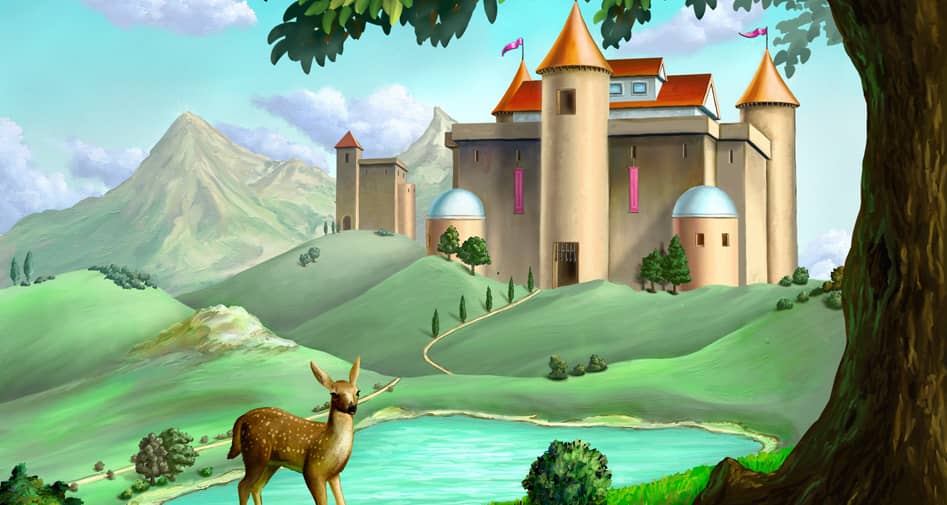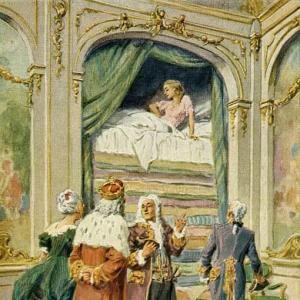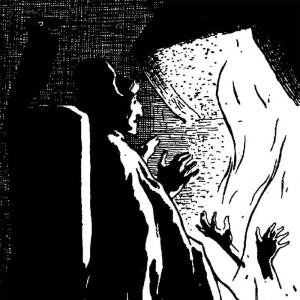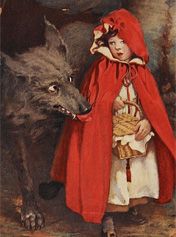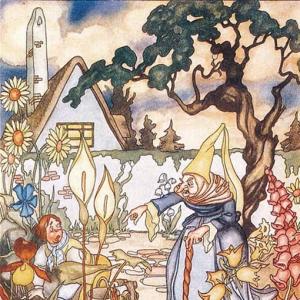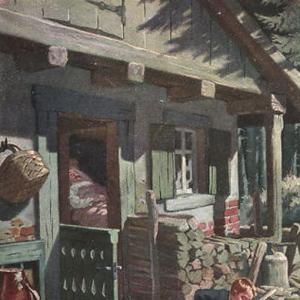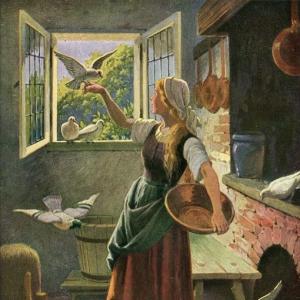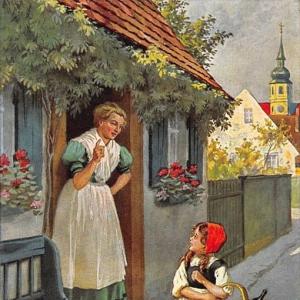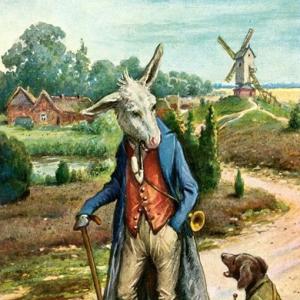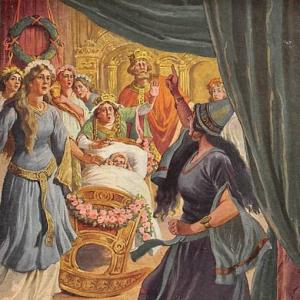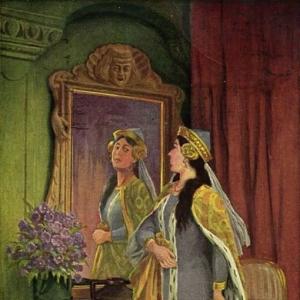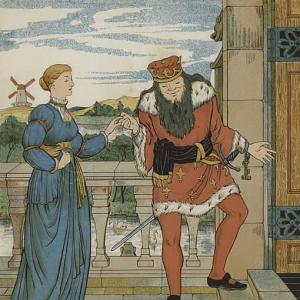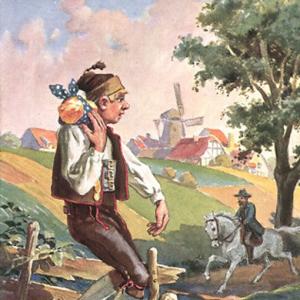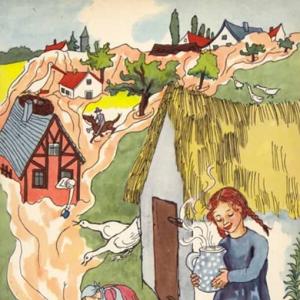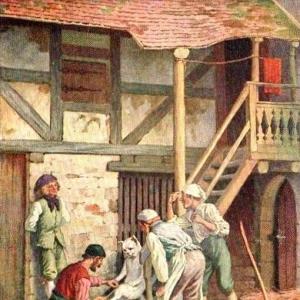Reading time for children: 5 min
When God had created the world and was about to fix the length of each creature’s life, the ass came and asked, „Lord, how long shall I live?“ – „Thirty years,“ replied God; „does that content thee?“ – „Ah, Lord,“ answered the ass, „that is a long time. Think of my painful existence! To carry heavy burdens from morning to night, to drag sacks of corn to the mill, that others may eat bread, to be cheered and refreshed with nothing but blows and kicks. Relieve me of a portion of this long time.“ Then God had pity on him and relieved him of eighteen years. The ass went away comforted, and the dog appeared. „How long wouldst thou like to live?“ said God to him. „Thirty years are too many for the ass, but thou wilt be satisfied with that.“ – „Lord,“ answered the dog, „is that thy will? Consider how I shall have to run, my feet will never hold out so long, and when I have once lost my voice for barking, and my teeth for biting, what will be left for me to do but run from one corner to another and growl?“ God saw that he was right, and released him from twelve years of life. Then came the monkey. „Thou wilt certainly live thirty years willingly?“ said the Lord to him. „Thou hast no need to work as the ass and the dog have to do, and wilt always enjoy thyself.“ – „Ah! Lord,“ he answered, „it may seem as if that were the case, but it is quite different. When it rains porridge I have no spoon. I am always to play merry pranks, and make faces which force people to laugh, and if they give me an apple, and I bite into it, why it is sour! How often sadness hides itself behind mirth! I shall never be able to hold out for thirty years.“ God was gracious and took off ten. At last man appeared, joyous, healthy and vigorous, and begged God to appoint his time for him. „Thirty years shalt thou live,“ said the Lord. „Is that enough for thee?“ – „What a short time,“ cried man, „when I have built my house and my fire burns on my own hearth. When I have planted trees which blossom and bear fruit, and am just intending to enjoy my life, I am to die! O Lord, lengthen my time.“ – „I will add to it the ass’s eighteen years,“ said God. „That is not enough,“ replied the man. „Thou shalt also have the dog’s twelve years.“ – „Still too little!“ – „Well, then,“ said God, „I will give thee the monkey’s ten years also, but more thou shalt not have.“ The man went away, but was not satisfied.
So man lives seventy years. The first thirty are his human years, which are soon gone. Then is he healthy, merry, works with pleasure, and is glad of his life. Then follow the ass’s eighteen years, when one burden after another is laid on him, he has to carry the corn which feeds others, and blows and kicks are the reward of his faithful services. Then come the dog’s twelve years, when he lies in the corner, and growls and has no longer any teeth to bite with, and when this time is over the monkey’s ten years form the end. Then man is weak- headed and foolish, does silly things, and becomes the jest of the children.
 Learn languages. Double-tap on a word.Learn languages in context with Childstories.org and Deepl.com.
Learn languages. Double-tap on a word.Learn languages in context with Childstories.org and Deepl.com.Backgrounds to fairy tale „The duration of life“
„The Duration of Life“ is a lesser-known fairy tale from the Brothers Grimm’s collection „Kinder- und Hausmärchen“ (Children’s and Household Tales). As with many other tales in the collection, „The Duration of Life“ is rooted in German folklore and oral tradition. The Brothers Grimm aimed to preserve these stories as part of Germany’s cultural heritage and folklore.
„The Duration of Life“ is a fable-like story that explains the varying lifespans of different animals, as well as humans. The tale is likely influenced by European folktales, myths, and possibly biblical stories. The Brothers Grimm collected their stories from various sources, such as oral traditions, written texts, and personal accounts from friends and acquaintances. Therefore, the background of „The Duration of Life“ can be traced back to these sources and the rich tapestry of European folklore.
In the story, God assigns lifespans to various animals, including the donkey, dog, monkey, and humans. Each creature receives a set number of years to live, and the story explains how these animals end up with their respective lifespans. The tale offers an imaginative and allegorical explanation for the different lifespans observed in nature and provides a lesson on the acceptance of one’s natural lifespan.
Overall, „The Duration of Life“ is an intriguing fairy tale that explores themes related to the natural order, the acceptance of one’s lifespan, and the idea that each creature has a predetermined purpose and time on Earth. These themes contribute to the story’s relevance within the Brothers Grimm’s collection of fairy tales.
Interpretations to fairy tale „The duration of life“
„The Duration of Life“ by the Brothers Grimm offers various themes and motifs that can be interpreted in multiple ways. Here are some possible interpretations of the story:
The natural order: The story demonstrates the natural order of things, where each creature has a predetermined lifespan. This concept reflects the idea that life follows a specific pattern, and every being has a role to play within this order.
Acceptance of one’s lifespan: The tale also emphasizes the importance of accepting one’s natural lifespan. It implies that each being is given a specific amount of time on Earth, and it is essential to embrace this time and fulfill one’s purpose.
Divine intervention: The story suggests that the lifespans of living beings are determined by a higher power, in this case, God. This interpretation highlights the role of divine intervention in shaping the lives of creatures and the course of nature.
Allegorical explanation of lifespans: „The Duration of Life“ provides an allegorical explanation for the varying lifespans of different animals and humans. Through a creative narrative, the story offers a way for readers to understand and make sense of the diverse lifespans observed in nature.
Greed and consequences: When the animals attempt to manipulate their given lifespans for a longer life, they end up with unintended consequences. This theme can be interpreted as a cautionary tale against greed and the potential negative outcomes of trying to tamper with the natural order.
In summary, „The Duration of Life“ is a thought-provoking tale that explores themes such as the natural order, the acceptance of one’s lifespan, divine intervention, allegorical explanations, and the consequences of greed. These themes contribute to the story’s enduring appeal and its place within the Brothers Grimm’s collection of fairy tales.
Adaptions of the fairy tale „The duration of life“
„The Duration of Life“ is not as well-known or widely adapted as some of the more famous tales by the Brothers Grimm, but it has still found its way into various forms of media, often as part of larger collections of Grimm’s tales. Here are some examples of its adaptations:
Children’s books: „The Duration of Life“ is sometimes included in collections of Grimm’s fairy tales aimed at children. These adaptations typically simplify the language and may include illustrations to help young readers better understand the story.
Anthologies: The story has appeared in anthologies of fairy tales and folklore, alongside other stories by the Brothers Grimm and other authors. These collections often present retellings or adaptations of the original stories, sometimes with updated language or additional commentary to provide context and analysis.
Audiobooks: „The Duration of Life“ has been adapted into audiobook format, where voice actors bring the characters to life and provide an engaging listening experience. These adaptations may focus on the story’s more thought-provoking elements, making creative use of sound to immerse listeners in the narrative.
Animated short films: Independent animators have occasionally adapted „The Duration of Life“ into short animated films. These adaptations may use various animation styles and techniques, such as stop-motion or computer-generated imagery, to visually represent the story’s themes and motifs.
While „The Duration of Life“ might not have as many adaptations as some of the more popular Grimm’s fairy tales, its thought-provoking themes and engaging narrative continue to inspire creative interpretations across various mediums.
Adaptions of the fairy tale „The duration of life“
„The Duration of Life“ is a lesser-known fairy tale from the Brothers Grimm collection that has inspired a few adaptations in various forms of media. Here are some examples:
Film adaptations: The story has been adapted into several short films, including the 2015 animated short film „The Duration of Life“ directed by Mathieu Labaye and the 2020 short film „The Fate of Things“ directed by Paulo Patoleia.
Theater productions: The tale has been adapted for the stage in various productions, including the 2016 production of „The Duration of Life“ by the Pig Iron Theater Company, which used the story as a starting point to explore themes of mortality and aging.
Literary adaptations: The story has also been adapted into novels and short stories, including „The Duration of Life“ by Frank Stockton, a short story that uses the same premise of a man who can determine the duration of life for others.
Music: The story has also inspired musical compositions, such as the song „Die Lebensdauer“ by German composer Kurt Weill, which is based on the tale and explores the themes of mortality and the transience of life.
Artistic adaptations: The tale has also been adapted into various art forms, including illustrations and paintings. One notable example is the 1882 painting by German artist Adolph Menzel, titled „The Duration of Life,“ which depicts a group of people gathered around a clock, emphasizing the theme of the passage of time and the inevitability of death.
Overall, „The Duration of Life“ has inspired various adaptations in different forms of media, highlighting the universal and timeless themes explored in the tale.
Summary of the plot
„The Duration of Life“ is a lesser-known fairy tale from the Brothers Grimm that explores themes such as the natural order and the acceptance of one’s lifespan. Here is a summary of the plot:
In the beginning, God assigns lifespans to various animals and humans. The donkey is given thirty years, the dog is given twelve years, the monkey is given ten years, and humans are given thirty years. The donkey, dog, and monkey each complain about their assigned lifespans, saying that it’s too long for them to endure, while humans complain that their lifespan is too short.
Eventually, the donkey, dog, and monkey strike a deal with humans, agreeing to give up part of their own lifespans to increase the human lifespan. As a result, humans now have a lifespan of seventy years, consisting of thirty years from their original allocation, eighteen years from the donkey, twelve years from the dog, and ten years from the monkey.
The story then goes on to explain the different stages of human life, each stage corresponding to the years received from each animal. In the first thirty years of human life, people work hard and are content with their lives. During the eighteen years from the donkey, they become more stubborn, carrying the burdens of life. The twelve years from the dog see people becoming weak and frail, much like an old dog. Finally, in the last ten years from the monkey, humans become silly and childish, often resembling the antics of monkeys.
„The Duration of Life“ is an allegorical tale that offers a creative explanation for the varying lifespans of different creatures and the stages of human life. It explores themes related to the natural order, the acceptance of one’s lifespan, and the idea that each creature has a predetermined purpose and time on Earth.
————
Backgrounds to fairy tale „The duration of life“
„The Duration of Life“ is a fairy tale collected by the Brothers Grimm, who were German scholars, linguists, and cultural researchers named Jacob and Wilhelm Grimm. They are best known for their work in the early 19th century, collecting and publishing German folklore and fairy tales in a book titled „Kinder- und Hausmärchen“ (Children’s and Household Tales), first published in 1812.
The Brothers Grimm were part of the Romantic movement in Europe, which focused on the importance of national identity, folklore, and cultural heritage. Their work aimed to preserve traditional stories passed down through generations, reflecting the values and wisdom of their time. As a result, their collection of fairy tales became an essential part of German literature and folklore.
While the Brothers Grimm did not write the stories themselves, they compiled, edited, and published them in a way that made them accessible to a broader audience. Over time, their work gained popularity and has been translated into numerous languages, influencing literature, popular culture, and the study of folklore worldwide.
„The Duration of Life“ is one of the lesser-known stories from their collection, but it offers valuable insights into human nature, the stages of life, and the importance of perspective and gratitude. The tale, like many others in their collection, has been passed down through oral tradition, reflecting the cultural wisdom and values of the time.
Interpretations to fairy tale „The duration of life“
„The Duration of Life“ offers multiple interpretations that can be drawn from the story, particularly focusing on the nature of life and the human experience. Some interpretations include:
Stages of life: The story highlights the different stages of human life, starting from youth and vitality to the later years, characterized by increasing burdens and declining health. This interpretation showcases the cyclical nature of life and the importance of understanding and accepting each stage.
Perspective on life: Each creature in the story views their life through the lens of their unique experiences and challenges, emphasizing the subjective nature of life. This interpretation serves as a reminder that everyone faces different trials and tribulations, and it is essential to consider the perspectives of others when examining the quality of life.
Gratitude and contentment: The man in the story is unsatisfied with his lifespan despite receiving additional years from the other creatures. This interpretation suggests that humans often struggle with contentment and gratitude, always seeking more than they have. Learning to appreciate and make the most of the time given is essential for a fulfilling life.
The human condition: The tale offers a reflection on the human condition, with the various phases of life highlighting the inescapable aspects of aging, responsibility, and mortality. This interpretation serves as a reminder that no one is exempt from these universal experiences, and it is crucial to embrace life with wisdom and humility.
Social commentary: The story can also be seen as a critique of societal expectations and the roles assigned to individuals throughout their lives. The allocation of years and the challenges faced by each creature may represent the unfair distribution of labor and the burdens placed on certain members of society.
Overall, „The Duration of Life“ provides a rich and thought-provoking narrative that invites readers to reflect on the nature of life, the human experience, and the importance of empathy, gratitude, and acceptance.
Summary of the plot
„The Duration of Life“ is a fairy tale by the Brothers Grimm that explores the different stages of life as experienced by humans and various animals. When God created the world and was about to decide the lifespan of each creature, the ass, the dog, and the monkey all asked for a reduction in the years initially assigned to them due to the hardships they would face.
The ass initially received 30 years, but asked for a reduction due to its burden-filled life of carrying heavy loads and receiving little appreciation. God reduced the ass’s lifespan by 18 years. The dog, who was also offered 30 years, requested a decrease due to the strain of running and eventual loss of its ability to bark and bite. God lessened the dog’s life by 12 years. The monkey, too, was granted 30 years but asked for a reduction, as its seemingly carefree life was often filled with disappointment and sadness. God took away 10 years from the monkey’s life.
When it was man’s turn, he was initially granted 30 years. However, he argued that this was too short, especially given the time needed to build a life and enjoy it. God agreed to add the years taken from the ass, dog, and monkey, totaling 70 years for man. Man was not satisfied, but God refused to give him more years.
The tale concludes by explaining that the different stages of man’s life consist of the human years (first 30 years), the ass’s years (next 18 years), the dog’s years (following 12 years), and the monkey’s years (final 10 years). Each stage represents different phases of life, with changing responsibilities, burdens, and eventual decline in physical and mental abilities.
Informations for scientific analysis
Fairy tale statistics | Value |
|---|---|
| Number | KHM 176 |
| Aarne-Thompson-Uther-Index | ATU Typ 173 and 828 |
| Translations | DE, EN, DA, ES, FR, PT, IT, JA, NL, PL, RU, TR, VI, ZH |
| Readability Index by Björnsson | 23.1 |
| Flesch-Reading-Ease Index | 90.6 |
| Flesch–Kincaid Grade-Level | 4 |
| Gunning Fog Index | 6.5 |
| Coleman–Liau Index | 7.4 |
| SMOG Index | 6.7 |
| Automated Readability Index | 3.9 |
| Character Count | 3.031 |
| Letter Count | 2.277 |
| Sentence Count | 43 |
| Word Count | 577 |
| Average Words per Sentence | 13,42 |
| Words with more than 6 letters | 56 |
| Percentage of long words | 9.7% |
| Number of Syllables | 700 |
| Average Syllables per Word | 1,21 |
| Words with three Syllables | 16 |
| Percentage Words with three Syllables | 2.8% |
